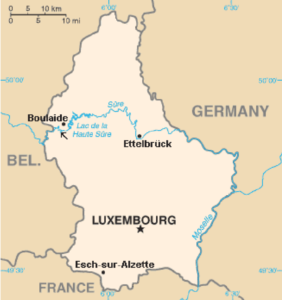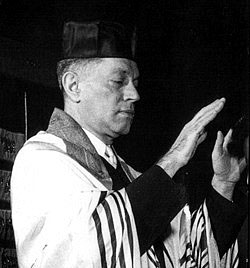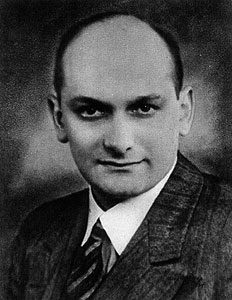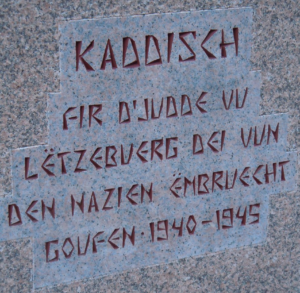 When the small European nation of Luxembourg became independent in 1815, there were fewer than 100 Jews in the country. The earliest records of Jewish residence in Luxembourg, however, date back to 1276. The first Jewish settlement followed in the early 14th century. While Luxembourg appeared fairly tolerant of its Jewish settlers, the outbreak of the Black Death proved how precarious the Jews’ situation was. They were blamed for the horrific plague and driven out of the country. Uninterrupted Jewish settlement in Luxembourg began after Napoleon’s march across Europe. By 1823, there was a large enough community for a synagogue in Luxembourg City, and a Chief Rabbi (Samuel Hirsch) was appointed in 1843. The Jewish community was founded in the late nineteenth century. The Great Synagogue was constructed in the capital and a second synagogue was built in Esch-sur-Alzette in 1899. For forty years the community flourished. By 1927, the Jewish community had grown to 1,171, most of whom had fled the Russian pogroms
When the small European nation of Luxembourg became independent in 1815, there were fewer than 100 Jews in the country. The earliest records of Jewish residence in Luxembourg, however, date back to 1276. The first Jewish settlement followed in the early 14th century. While Luxembourg appeared fairly tolerant of its Jewish settlers, the outbreak of the Black Death proved how precarious the Jews’ situation was. They were blamed for the horrific plague and driven out of the country. Uninterrupted Jewish settlement in Luxembourg began after Napoleon’s march across Europe. By 1823, there was a large enough community for a synagogue in Luxembourg City, and a Chief Rabbi (Samuel Hirsch) was appointed in 1843. The Jewish community was founded in the late nineteenth century. The Great Synagogue was constructed in the capital and a second synagogue was built in Esch-sur-Alzette in 1899. For forty years the community flourished. By 1927, the Jewish community had grown to 1,171, most of whom had fled the Russian pogroms
 The Jewish population surged in the 1930’s to approximately 4,000, as refugees fled Nazi oppression in neighboring Germany. A the beginning of the Nazi occupation, Rabbi Serebrenik organized a series of clandestine escapes of the Jewish population into southern, unoccupied France, as well as official convoys of those with proper visas out of Luxembourg to Lisbon. In fact, from November 1940 through June 1941, Rabbi Serebrenik succeeded in transferring 2,000 Luxembourg Jews out of Luxembourg. By the Spring of 1941, three quarters of the Luxembourg Jewish population that was there on the day of the Nazi invasion had managed to escape from the Nazis. Before he was transported, Rabbi Serebrenik also managed to save another 250 Jews. Very few people who were sent to the camps, returned.
The Jewish population surged in the 1930’s to approximately 4,000, as refugees fled Nazi oppression in neighboring Germany. A the beginning of the Nazi occupation, Rabbi Serebrenik organized a series of clandestine escapes of the Jewish population into southern, unoccupied France, as well as official convoys of those with proper visas out of Luxembourg to Lisbon. In fact, from November 1940 through June 1941, Rabbi Serebrenik succeeded in transferring 2,000 Luxembourg Jews out of Luxembourg. By the Spring of 1941, three quarters of the Luxembourg Jewish population that was there on the day of the Nazi invasion had managed to escape from the Nazis. Before he was transported, Rabbi Serebrenik also managed to save another 250 Jews. Very few people who were sent to the camps, returned.
V ictor Bodson lived close to the river Sauer, which acts as the border between Luxemburg and Germany. Beginning in 1933, he offered refuge at his house to German-Jewish refugees who had successfully crossed the river. Using a special apparatus in his car, he would ferry these people to a safe haven that had been prepared in advance by his friends .He saved about 100 Jews in this way. 1940, when the Germans invaded Luxembourg, Bodson fled, as he was wanted by the Gestapo for interrogation.
ictor Bodson lived close to the river Sauer, which acts as the border between Luxemburg and Germany. Beginning in 1933, he offered refuge at his house to German-Jewish refugees who had successfully crossed the river. Using a special apparatus in his car, he would ferry these people to a safe haven that had been prepared in advance by his friends .He saved about 100 Jews in this way. 1940, when the Germans invaded Luxembourg, Bodson fled, as he was wanted by the Gestapo for interrogation.
On 22 October 1940 the synagogue of Esch was destroyed. Today, its remnants can be seen in Place de la Synagogue, just up the street from our current building. Throughout Occupied Europe, many members of our community were deported and killed by the Nazis, their names are recorded on a monument erected on the site of the old synagogue. In May 1941 the synagogue of Luxembourg City was closed by the Gestapo, vandalised and then razed, which took until autumn of 1943.
 After World War II, some 1,500 Jews returned to the country, the majority being merchants who wished to rebuild their businesses. Both the country’s synagogues were destroyed during the war. However, with financial support from the government, the community rebuilt The Great Synagogue of Luxembourg in 1953, and likewise, the Canal Synagogue in Esch-sur-Alzette a year later.
After World War II, some 1,500 Jews returned to the country, the majority being merchants who wished to rebuild their businesses. Both the country’s synagogues were destroyed during the war. However, with financial support from the government, the community rebuilt The Great Synagogue of Luxembourg in 1953, and likewise, the Canal Synagogue in Esch-sur-Alzette a year later.
Today there are roughly 1,200 Jewish people living in the Grand Duchy. While the number is growing thanks to immigration, the size and influence of Luxembourg’s Jewish population is a far cry from what it once was. About 80 percent of the Jews live in the capital city, also known as Luxembourg, with a much smaller community in the nearby town of Esch-sur-Alzette.